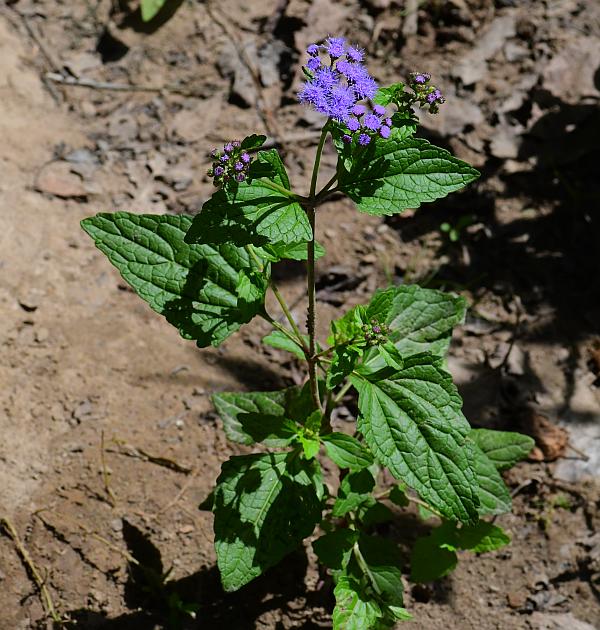Conoclinium coelestinum (L.) DC.
Mist-Flower

Native
CC = 3
CW = 0
MOC = 64
© SRTurner
Conoclinium coelestinum (L.) DC.Mist-Flower | |
 |
Native CC = 3 CW = 0 MOC = 64 |
© SRTurner |
|
Family - Asteraceae/Eupatorieae Habit - Rhizomatous perennial forb, usually colonial. Stems - Ascending to erect, to 90 cm, simple or branched, moderately to densely pubescent with short, curly hairs.
Leaves - Opposite, simple, well-spaced, short- to long-petiolate. Blades 1-10 cm long, triangular-ovate to narrowly triangular, broadly angled to truncate at the base, narrowed or tapered to a usually sharply pointed tip, the margins shallowly scalloped or bluntly toothed, both surfaces glabrous or minutely hairy, usually only along the veins, the undersurface also glandular, with mostly 3 main veins.
Inflorescence - Small panicles at the branch tips, flat-topped or less commonly dome-shaped. Peduncles densely short-hairy, with small subulate bracts to 1 mm long.
Heads - Discoid, bell-shaped, with 35-70 florets. Involucre 3-5 mm long, the bracts 18-30 in usually 2 or 3 somewhat unequal to nearly equal, overlapping series, narrowly elliptic to narrowly lanceolate, tapered to a sharply pointed, often purple tip, all but the outermost finely few-nerved or few-ribbed, sparsely to moderately short-hairy and usually also glandular. Receptacle conical.
Ray flowers - Absent. Disk flowers - Corollas purple to lilac, 5-lobed. Stamens 5, included. Style well exserted and bifurcate, pink or purple, glabrous. Pappus of numerous capillary bristles.
Fruits - Achenes 1.6-2.4 mm long, finely 5-ribbed, slightly wedge-shaped in profile (usually slightly and unevenly tapered at the base), glabrous, the ribs smooth or with a few minute, ascending teeth, lighter colored, the body otherwise irregularly glandular and dark brown to black.
Flowering - August - October. Habitat - Bottomland forests, streambanks, swamps, pond margins, marshes, other moist ground. Also cultivated. Origin - Native to the U.S. Lookalikes - Fleischmannia incarnata, cultivated Ageratum spp. Other info. - This pretty and delicate little species can be found mainly in the southern 2/3 of Missouri. It is also common throughout the southeastern continental U.S., and ranges into Canada as well. It is easy to identify by its light purple, discoid flowering heads and opposite leaves. It could be mistaken for the commonly cultivated and closely related Ageratum, but that plant is generally not found growing outside of cultivation. It also resembles Fleischmannia incarnata, but that plant is much less common, usually much taller, and with florets fewer per head and more pinkish in color. Photographs taken along the shores of the Current River, Shannon County, MO., 7-15-03; and in Lochapoka, AL., 10-5-04 (DETenaglia); also at Onondaga Cave State Park, Crawford County, MO, 9-25-2014; Young Conservation Area, Jefferson County, MO, 8-30-2016, near Labadie, Franklin County, MO, 8-18-2020 and 10-31-2020; and along the Al Foster Trail near Glencoe, St. Louis County, MO, 9-09-2021 (SRTurner). |